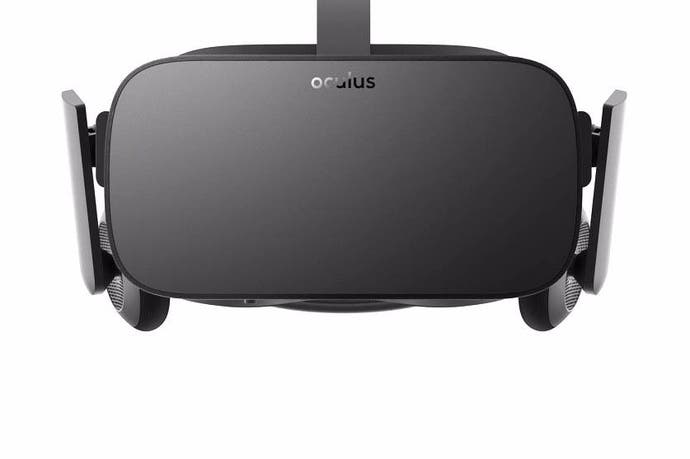Oculus Rift review
Virtual reality check.
The biggest surprise coming out of our Oculus Rift testing? This isn't just a piece of hardware. It's a platform. Once you strap on the display and immerse yourself into Oculus Home - the front-end of the system - this becomes obvious. Buying games, accessing your library, downloading content, hooking up with friends, watching media, launching titles and switching between them - it's all done within a beautifully realised VR world. There's a console-style sense of solidity and polish to the whole enterprise. And as long as you stick to Oculus' minimum PC spec, just about everything just works.
Oculus is intent on proving that by kitting out the press with a reference platform based on an Asus G20 small form-factor PC, an Asus VE198 monitor, plus the Rift package itself. The pleasant surprise here is that the G20 itself barely scrapes the Oculus min-spec, when the more obvious choice may have been to supply press with the absolute state of the art in PC technology. As things stand, we have the requisite Nvidia GeForce GTX 970, but CPU-wise, the reference units features a base-level Core i5 6400 - the bottom rung 2.7GHz quad-core processor in Intel's latest Skylake line-up. Curiously, this is actually less powerful than the Core i5 4590 previously announced as VR's entry-level CPU.
Despite this, the polish and consistency across the exceptional UI - and indeed the lion's share of the launch games themselves - is highly accomplished. With just barely perceptible, highly infrequent stutter on a small batch of games, the Rift delivers a locked 90fps across the experience from start to finish. Going into this review, we were prepared to roll up our sleeves, break out the overclocking tools, and adjust GPU control panel settings to get the best possible VR experience. The beauty of the Oculus Rift is that after a short set-up procedure, you're good to go with the minimum of tweaking - in most cases, at least.
Hardware breakdown
After two public development kit releases, plus the unreleased Crescent Bay prototype, there's a strong sense that Oculus is finally ready for show time. It begins with the hardware itself. Out of the box, the final consumer Rift doesn't exactly have a wow factor - the design is first and foremost informed by function and practicality - and build quality isn't as good as it could be (the foam liner detaches easily, for example). However, the comfort level is certainly a step up from Crescent Bay and DK2 - the width of the headset remains fairly narrow, but crucially, I was able to wear it without removing my glasses. It's a tight fit, but this is something I couldn't achieve with the last prototype. There's still some light leakage via the bridge of the nose, but some form of ventilation was required after the thorny issue of the lens fogging issues encountered with initial development kits. A single USB 3.0 cable emerges from the headset, along with an HDMI 1.3 cable.
The Rift is secured in place with Velcro fastenings on the side and top of the headset, and there's a spring-loaded mechanism for pushing the HMD away from your face and easily removing it. Final adjustments are carried out with a slider on the underside of the Rift, adjusting for pupil distance. A step-by-step guide for setting up the headset ensures that everything looks and feels good before you begin - and at 470g the headset is certainly light enough to wear for extended periods. The set-up and calibration phase ends with a trio of tech demos - short, but visually arresting.
Everything sounds great too. Unlike its competitors, Oculus Rift ships with an integrated audio solution, so there's no need to strap on a pair of cans. The headphone components are eminently swivelable, easy to adjust or indeed pull away. Audio quality is beyond expectations here - the sound is very well-balanced, equally at home with fairly deep bass as well as high frequency detail. Even with the volume pushed to the max, there's no distortion here. This was one of the more surprising elements of the Rift's hardware make-up. The reality is that while audiophile quality high-end headphones will offer a better aural experience, most gamers will get on just fine with the standard solution. It certainly helps in keeping the amount of hardware strapped to your head to the absolute minimum.
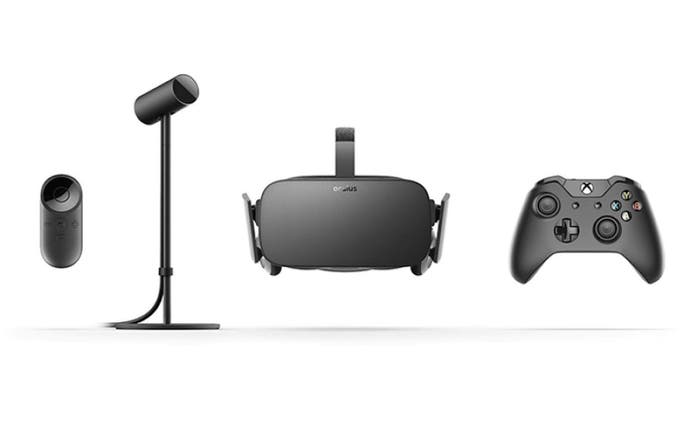
Visual quality is impressive overall too. The Rift has 1080x1200 of resolution per eye, offered up via a 90Hz, low latency OLED display. It's a world apart from the older DK prototypes, based on off-the-shelf smartphone screens. Motion blur is minimised to the point of irrelevance, colour reproduction is beautiful. The 110 degree field of view works well too, though you are aware of black circular borders to the left and right as you play, something the Rift has in common with both Vive and PSVR. The raw pixel count is still an issue though - albeit much improved over previous prototypes. With your eyes pressed so closely against the panel, it's inevitable that you see the 'screen door' effect, visible here in a kind of diagonal pattern. It's possible to make out the edges of the pixels, but thankfully, not their RGB sub-pixel make-up. The extent to which it's noticeable depends on two factors - whether you're actively going out to look for it, and the nature of the content. Once focus shifts to mid-distance, you tend not to notice it. The overall presentation is rather soft though, but as you adjust, the compromises tend to fade away - the low resolution only really makes a negative impact on games with poor anti-aliasing and/or sub-pixel break-up.
There are three other hardware components bundled with the Rift - firstly, the sensor used for positional tracking. By and large it works beautifully, though its field of view in a desktop gaming set-up can be constrictive depending on how close you're sitting. Obviously, the nearer you are, the more likely you are to encounter occlusion issues that prevent accurate tracking, which can lead to the occasional sudden lurch. Secondly, there's the remote - required for basic navigation through the Oculus Home interface, though the bundled Xbox One controller is capable of doing the same job.
With the lack of Oculus Touch controllers at launch, the standard Microsoft pad is the control option of choice for VR. It comes packaged with the wireless receiver dongle, a USB extension cable, plus a couple of Duracell AA batteries. It's disappointing that the Rift does not ship with 3D controllers, but right now, the Oculus offering is very much orientated towards seated games, and the majority of the launch titles are designed to operate with a pad. It's an interesting contrast to SteamVR's more active, interactive approach, where the 3D interface takes centre-stage.
Oculus Home - the front-end and non-gaming content
Once set-up is complete and the Rift is in place, you're transported to Oculus Home - offering the same core functionality as the standard, rather pedestrian Windows front-end but completely re-imagined for VR. You're transplanted into the titular home - the living room specifically, the diner and kitchen behind you. In front of you are the main interface options. Choosing them is straightforward enough: a cursor permanently sits right in front of you in a fixed position, and you simply adjust your gaze to carry the cursor over the option you want. From there, you select using the Oculus Remote or the Xbox controller.
Oculus has effectively built its own entirely feature-complete VR front-end and it's a beauty: attractive to look at, easy to navigate, and almost entirely self-contained. You can see what the objective here was - to integrate as much as possible into the VR space, to divorce virtual reality from the world of Windows as much as possible. There's just one problem - the majority of the games tested appear to require additional permissions to finish the install that (for some reason) aren't possible to complete in VR. This requires removing the headset, finalising the install in the Windows app, then OKing a Windows prompt. Fingers crossed that this issue can be resolved in the fullness of time - it's the one blemish on an otherwise faultless UI.
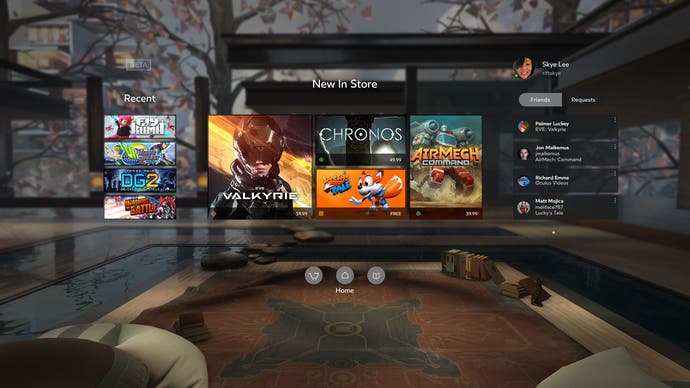
Oculus Home demonstrates just how far the firm has come not just in terms of the hardware, but the software too. It's attractive, minimalistic, easy to navigate and also plays host to a wealth of content that's well worth checking out. A lot of it is entirely free too, meaning there's plenty of material to sample once you've set up the Rift - even before you begin playing any games. There's a trio of entirely real-time CG animated shorts - Henry, The Invasion and Lost. These may have limited short-term appeal, but they will get a lot of repeat viewing simply because they're all so cool. On top of that, there's the Oculus Dreamdeck too, a compilation of VR vignettes that range from simple demos to epic experiences. Again, you're unlikely to revisit them yourself, but you'll want to share them.
Other non-gaming apps include Oculus Jaunt - a VR travelogue of sorts, using 360 degree video to transport you to tourist spots around the world - along with Oculus Video. There's more 'surround' video content here, including Facebook 360-degree offerings (low frame-rate, low bit-rate - they don't look great) along with a bunch of cinema-style portals for the likes of Vimeo and Twitch. You can also copy over your own videos into Windows' My Videos folder and watch them in the virtual cinema (complete with a range of selectable surroundings). It's a neat effect initially, but the low resolution and curiously poor colour reproduction makes it a short-lived gimmick. On top of the video options, Oculus Home also has an app for viewing 360-degree photographs.
Oculus Rift - the gaming experience
The Rift ships with two free games - 3D shooter Eve Valkyrie and Mario-style platformer Lucky's Tale - but the point is that Oculus has worked hard to sell VR as a concept where gaming is just one component, albeit a key one. Much of the VR video may well look somewhat 'first-gen' in nature, but it's a compelling proof of concept. Facebook's Mark Zuckerberg has often talked of the possibilities here - like transporting you into the middle of a music concert - and Oculus Home provides a pretty decent example of just that. On top of that, the CG shorts do make you sit back and wonder about the extent to which VR could provide an alternative stage for movies and other non-interactive content by actually placing you within the scene.
Of course, the games are the focus though. We've had our worries about VR, specifically in terms of guaranteeing the quality of the experience. Titles need to run at a locked 90fps in order to preserve the quality of the immersion, and also to stave off nausea issues. The most pleasant surprise from our testing is that the rock-solid nature of the interface persists into the majority of the games we played, which do indeed deliver the locked performance level required - even on the base spec 'VR ready' Asus G20 that Oculus supplied for review.
Now, several of the games here are quite simplistic in nature, so won't really trouble a GPU as capable as the GTX 970, but visually they punch above their weight owing to the fact that 'presence' - the idea that you are indeed situated within the virtual world - is so well realised. Pack-in title Lucky's Tale is a supreme case in point. Played in 2D, it is what it is, a playable enough Mario clone but nothing earth-shattering. Presence turns a generic platformer into something fresh and compelling. Imagine being transported into a Mario level, with the ability to look around the environment in all directions, with exceptional draw distances. You can plot multiple routes around the stage simply by looking around, while intelligent use of the fixed camera works to gently nudge you in the right direction.
Lucky's Tale presents the environment not as an abstract 2D plane in front of you, but as something else - offering something akin to a close-up view of a miniature model. There are some exceptionally cute moments too. Spotting a glint of a hidden coin behind a wall, I moved in closer and literally looked around the corner - and there it was. However, looming deeper into the playspace brought me much closer to Lucky himself, who jumped back in surprise. Other close encounters with the main character bring similarly humorous responses - it's simply delightful stuff. VR has moments that are both epic and somewhat smaller in scale, but they're all priceless. That's the beauty of this amazing new canvas that developers have to work with - and exactly the kind of feeling I got from Valve's recent SteamVR showcase. Games feel new again, even those based very closely on existing non-VR titles.
And the big takeaway from all my VR experience so far is that what you think you want from the hardware isn't necessarily what's going to be most effective. Slightly Mad Studios' Project Cars is the most overt 'triple-A' game on the launch roster, but actually serves to demonstrate that non-VR titles ported to the platform may not pay off for everyone. First of all, there's the question of spec. You can boot and play the vast majority of the launch titles and they run perfectly right off the bat on base-spec hardware - not so Project Cars, which clearly requires some serious hardware to achieve the required locked 90fps. We can well imagine that those who sink enough cash into their PC set-ups will get this game looking and running beautifully, and the VR payoff is obvious - however, despite the common view that cockpit games translate well into VR, I still felt quite ill playing it within 15 minutes. The disconnect between in-game motion and the lack of it in real life causes severe nausea issues here, just as I experienced playing another cockpit game: Elite Dangerous on Vive.
Another ported title - The Vanishing of Ethan Carter - is more effective. The non-VR version is a visual treat (especially so via its Unreal Engine 4 upgrade), but the move to Oculus Rift is a genuine game-changer. Just experiencing this game world in VR, in effect just being there is - and I don't use this word lightly - incredible. Out of the box, settings are well-tuned too, meaning that these stunning visuals lock at 90Hz on the base-spec hardware. The image isn't pristine, being somewhat blurry with intrusive sub-pixel break-up - but that's exactly because The Astonauts have tailored default settings so that those with the lowest acceptable specification in hardware do get that locked frame-rate.
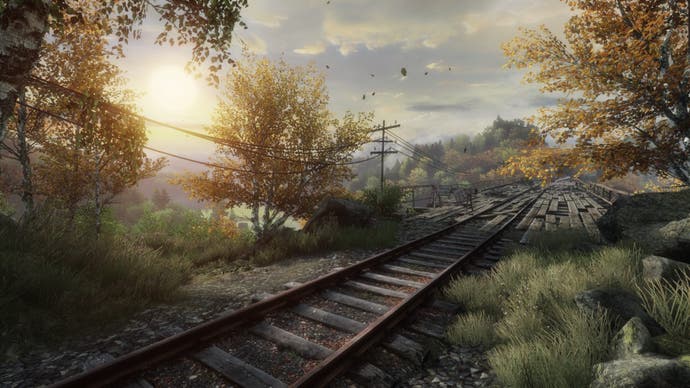
A look at the settings explains all. By default, Ethan Carter is set up with an 80 per cent resolution scale, plus FXAA anti-aliasing is in play, causing the pixel-pop. Temporal AA removes the sub-pixel issues, while increasing the resolution scale to 100 per cent or higher mitigates the blur. From there, the game looks glorious - but frame-rate suffers. Faster graphics hardware is required to get the most out of this game, but at least The Astronauts have shipped with settings that ensure a fluid, consistent experience for all users running at least minimum spec. For those with more capable gear, the only way is up.
VR motion sickness - and how Oculus tackles it
Unfortunately, Ethan Carter has comfort issues too, for exactly the same reason as Project Cars - a large disconnect between motion as you see it and as you feel it. The difference is that The Astronauts have included a comfort mode, effectively robbing you of free movement in the game world. Instead, the game viewpoint has you rooted to the spot, navigating around the world by clicking on in-world arrows that take you where you want to go. It feels like a compromise too far, but it does comprehensively address the issue.
Short of 'nuclear' options like Ethan Carter's comfort mode, there's no way to overcome VR motion sickness, but Oculus has bravely tackled it by attaching comfort ratings to each game on its store. There was some dismay at Oculus' approach here, but based on the experience of playing a range of titles, it's the right move. Players should be informed of potential comfort issues before they lay out the cash. The system also demonstrates that solving the comfort issue is as much about software as it is about the design of the headset. The Rift's motion tracking, low-persistence screen and 90Hz refresh appear to have resolved most of the design problems, but there's still the sense that game-makers need to work around the strengths and weaknesses of the platform. Ported non-VR content is always going to be at a disadvantage in this scenario.
Of course, the comfort issue may well vary from user to user, but by and large, I found Oculus's ratings to be unerringly accurate. I couldn't hack more than 15 minutes of Ethan Carter or Project Cars - both rated as 'intense' - without taking a break. By contrast, Lucky's Tale is rated 'moderate' and I played for 45 minutes straight before feeling even the slightest twinge of discomfort. Games with a relatively static camera - like VR Tennis Online - receive the 'comfortable' rating and I feel as though I could play them all day.
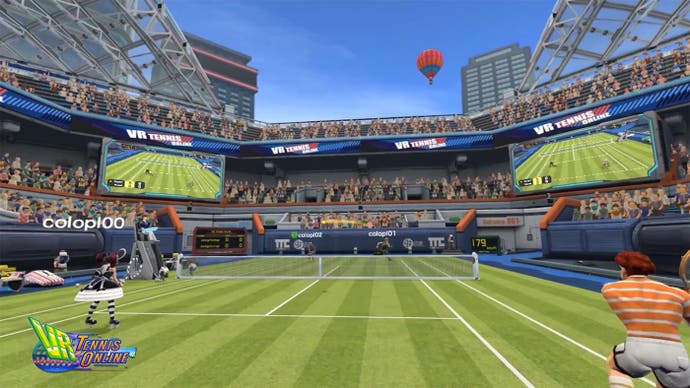
Oculus Rift: the Digital Foundry verdict
From a hardware perspective, Oculus Rift delivers. As a spectacles wearer with less than stellar experiences using the Crescent Bay prototype, I was concerned that Oculus may have lost pace compared to the more comfortable HTC Vive and PlayStation VR, but the final hardware delivers. Image quality is up there with the best, latency in motion response is a non-issue (a rapid shake of the head during gameplay confirms this - the image remains perceptually rock solid) and the integrated headphones are way, way better than I thought they would be. The headset is well-designed, build quality is good and the immersive experience overall is breathtaking.
There's also much to commend in the platform Oculus has delivered, in terms of the wide scope of its content, the (almost) fully integrated VR interface, and the way in which the vast majority of games just work, even on the min-spec PC hardware platform. There's an almost console-like level of accessibility here that guarantees a great experience with minimal effort. There's also the notion that VR is going to revolutionise more than gaming alone - the wealth of freebies in the Oculus store is a great touch in this sense. It gets you excited about the future of the platform, enough that you want to share the Rift with family and friends.
The overall offering feels very different to SteamVR right now - which is a wholly games-based enterprise. Of course, much of that is down to the spec differential with the HTC Vive. The Rift has no 3D controllers at launch, so games based heavily on 3D interactivity are mostly non-existent. There's nothing as ambitious as Budget Cuts or Job Simulator on the Oculus Store. There are no 'walkabout' room-scaling games (at least, right now) because the Oculus camera is not as functionally rich as Vive's laser-tracking lighthouses. From what we've played so far, Vive's launch catalogue focuses on those strengths, while Oculus Rift is very much about the seated VR experience - which many may prefer. In theory, Vive can do everything the Rift can and more, but it's interesting to note a large degree of segregation in the launch line-ups of both devices, with only Elite Dangerous accommodating both. A software head-to-head will have to wait, for now.
But in the meantime, I can safely say that those who've pre-ordered the Rift are unlikely to be disappointed with the quality of the end product and the experience it delivers - VR is like nothing you've ever experienced before. It's been almost three years since I first took delivery of my DK1 Kickstarter unit. Back then, the hardware wasn't up to scratch, the experience didn't live up to expectations and I felt that Oculus had a real mountain to climb in turning what was clearly experimental hardware into a consumer-ready product. The great news is that Oculus has done it. The Rift is highly recommended, and I can't wait to see where this revolutionary technology takes us.
